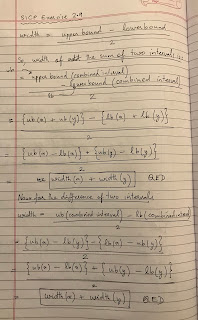SICP Exercise 2.9 width-of-interval

Exercise 2.9. The width of an interval is half of the difference between its upper and lower bounds. The width is a measure of the uncertainty of the number specified by the interval. For some arithmetic operations the width of the result of combining two intervals is a function only of the widths of the argument intervals, whereas for others the width of the combination is not a function of the widths of the argument intervals. Show that the width of the sum (or difference) of two intervals is a function only of the widths of the intervals being added (or subtracted). Give examples to show that this is not true for multiplication or division. SOLUTION The code and tests are here . Observation: The width of the added and subtracted intervals is the sum of the widths of the component intervals. But this is not true for multiplication and division.